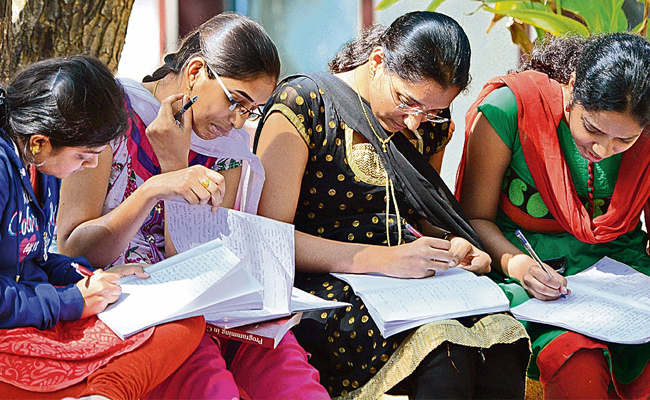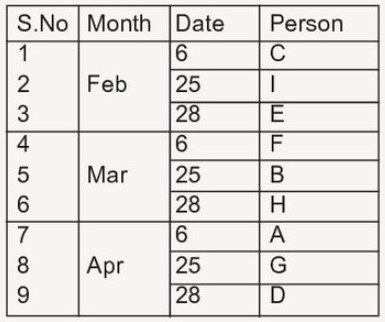Bank Exams Model and Preparatory Questions in Reasoning

Model Questions
Directions (1-5): Read the given information and answer the given question
There are some people are sitting in a row facing North. Six persons sit between L and J. Three persons are sitting between M and N. K is third to the right of N. K is second to the left of P. Number of people between M and P is same as the number of people between M and L. Only three people sit to the left of L. Two people sit between P and R. R is sitting at the second position from one of the ends.
1. How many persons are sitting in the row?
A) 27 B) 28
C) 19 D) 18
E) 26
2. What is the position of J with respect to M?
A) 2 nd to left B) 3 rd to right
C) 2 nd to right
D) 3 rd to left
E) Immediate left
3. How many persons are sitting between M and P?
A) 9 B) 12
C) 8 D) 7
E) 10
4. Which of the following statements is true?
A) J sits to the right of K. B) Seven people are sitting between N and R.
C) Less than 10 people sit between P and L.
D) 9 people sit between J and P. E) None of the statements is correct.
5. How many people are sitting to the left of K?
A) 19 B) 8 C) 9
D) 15 E) 12
Directions (6 - 10): Read the given information and answer the given question
A boy has arranged nine books P, Q, R, S, T, U, V, W and X one above the other but not necessarily in the same order. There are 5 books between book P and book R. Book T is kept immediately above R. 3 books are kept between book T and book S. Number of books between P and S is same as the number of books between T and Q. Book U is kept below book Q. Book W is kept somewhere below X. There is only one book kept between U and V. U is above V.
6. Which of the following statements is not true?
I) There are two books between T and Q.
II) S is kept below W.
III) U is kept immediately above P.
A) Only I B) Only II
C) Only III D) Both II and III
E) All I, II and III
7. V is related P and Q is related to X in certain manner. To which of the following is U related in the same manner?
A) W B) R
C) S D) T
E) X
8. How many books are kept between X and P?
A) Five B) Two
C) Three D) Four
E) None
9. Which of the following pair of books is kept immediately above and below book Q respectively?
A) XS B) SX
C) RW D) WR
E) None of these
10. What is the position of book W in the given arrangement?
A) Between P and V B) Fourth from the top. C) Sixth form the bottom.
D) Fourth from the bottom. E) Between R and Q.
Direction (11-15): Study the information given below and answer the questions based on it.
There are 9 management graduates A, B, C, D, E, F, G, H and I. Each of them have their birthday in one of the three months - February, March and April of the same year,but not necessarily in the same order. They are also born on three different dates 6, 25 and 28. Each person has an interview on the same day (on the same date of the same month) he was born. Only three persons have interviews between F and G. F is born before G. A is born immediately before or after G. I is born in a month which has less than 30 days and the date is a multiple of 5. There was only one person born between I and F. B and H have interviews in the same month. H was born on a date which is a multiple of 14. E and D were born on the same date. E was born before D. The number of persons born between F and G is the same as that of E and A.
11. How many persons have interviews between E and H?
A) 3 B) 6 C) 4 D) 2 E) 5
12. Which group of persons were born in the month of April?
A) C, F, A B) F, B, G C) A, G, D D) F, B, H E) None of these
13. G was born on which of the following dates?
A) 28 February
B) 6 February
C) 25March
D) 6 March E) None of these
14. Find the odd one out.
A) BH B) FB
C) GA D) EI
E) CD
15. Which of the following is the correct combination of month date and persons?
A) March - F - 25 B) February - B - 6 C) April - A - 6 D) March - B - 28
E) February - E - 25
Directions(16-20): In each question below three statement followed by two conclusions numbered I and II. You have to take the two given statements to be true even if they seem to be at variance with commonly known facts and then decide which of the given conclusions logically follows from the given statements disregarding commonly known facts.
A) Only conclusion I follows.
B) Only conclusion II follows.
C) Either conclusion I or II follows.
D) Both conclusions I and II follow. E. Neither conclusion I nor II follows.
16. Statement:
D ³ B > F; B > M >A;
F > C; R < C
Conclusion:
I. C < D II. F < A
17. Statement:
D £ R > E £ B;
S £ M = E > G = B
Conclusion:
I) D > G II) D £ B
18. Statement:
E £ S > F £ C; T £ N = F >P;
H > C
Conclusion:
I) T < C II. C = T
19. Statement:
M = L ³ N ³ Q < P < V ³ S;
Q > G
Conclusion:
I. G ³ S II. M > G
20. Statement:
Q > A ³ Z £ X £ C; Z ³ H; A> D
Conclusion:
I. Q > H
II. Z £ D
Solutions
(1-5):
By considering the points, (I)K is third to the right of N,(II)K is second to the left of P, (III) three persons are sitting between M and N and(IV)Number of people between M and P is same as the number of people between M and L, only one possible arrangement follows as given below.
L_ _ _ _ _ _ _ _ M _ _ _ N _ _ K _ P
Based on the other points, the final seating arrangement is as follows.
_ _ _ L_ _ _ _ _ _ J _ M _ _ _ N _ _ K _ P _ _ R _
1) E; 2) A; 3) C; 4) B; 5) A
(6-10): Based on the statement "There is only one book kept between U and V. U is above V." there is only one possibility which is given below.
| Number | Books |
| 9 | T |
| 8 | R |
| 7 | X |
| 6 | Q |
| 5 | S |
| 4 | W |
| 3 | U |
| 2 | P |
| 1 | V |
6) B; 7) A; 8) D; 9) A; 10; D
(11-15): The date of interview is nothing but the date on which the person was born.
Based on the statement, "The number of persons born between F and G is the same as that of E and A" there is only one possibility as given below:

16) A;
By combining the given expressions,
D ³ B > F>C.
Hence, C<D follows
F < B > M >A.
We cannot determine the relation between F and A.
Only I follows
17) C;
By combining the expressions we get D £ R > E £ B = G. Hence, the relation between D and G ( G = B) cannot be determined. But, either I or II follows.
18) C;
Based on the statements,
T £ N = F £ C.
Hence, Either I or II follows.
19) B;
By combining the statements,
G < Q < P < V ³ S.
Hence, Conclusion I does not follow.
M = L ³ N ³ Q > G.
Hence, Conclusion II follows
20) A;
By combining the statements,
Q > A ³ Z ³ H.
Hence, Conclusion I follows.
D < A ³ Z Hence, the relation between Z and D cannot be established. So, Conclusion II does not follow.
Tags
- banks reasoning
- bank exams in reasoning
- competitive bank exams
- bank exams reasoning model questions
- model and practice questions for bank exams
- bank exams preparation
- bit banks for bank exams
- reasoning bit banks
- bit banks for reasoning bank exams
- reasoning exam for bank jobs
- Education News
- Sakshi Education News




















